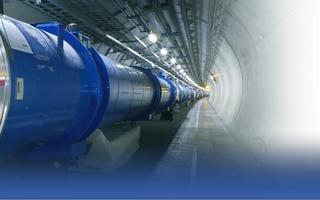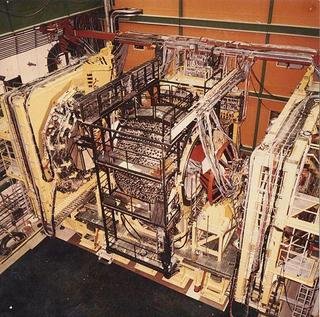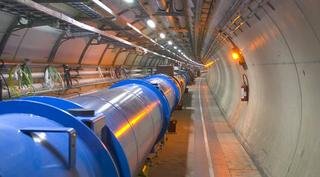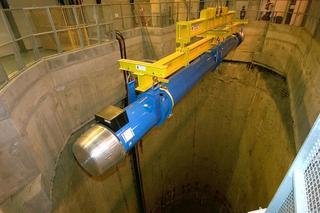The Large Hadron Collider - the story of the largest man-made experimental apparatus
I have already written a lot of articles on what was going on at the Large Hadron Collider, one of the main physics experiments on-going at CERN, as well as on some of its physics results.

[image credits: CERN]
Among those results, one can clearly consider the discovery of a Higgs boson, in 2012, an event that can also be seen as the triumph of the Standard Model of particle physics.
This indeed makes the Standard Model one of the most remarkable achievement of the last 50 years in physics
I will however not talk about the Higgs boson this time, as I did that already many times.
I will instead take the time to browse the big lines of the LHC story, a success story of more than 30 years that will continue for about the next 20 years. In future articles, I may discuss the different experiments running at the LHC, and their goals. But today, it is time for the LHC history!
THE DISCOVERY OF THE WEAK BOSONS AT THE SppbarS
In order to start to discuss the LHC story, it is good to go back in the early eighties, when the W-boson and Z-boson were discovered. I recall that these two guys are the two elementary particles responsible for the mediation of the weak interactions in the Standard Model of particle physics.
These two weak bosons were discovered at the CERN SppbarS machine, the first high-energy hadronic collider of CERN.
By hadronic collider, I mean a machine colliding hadrons, or in other words particles constituted of strongly-interacting particles. The latter in particular include protons, antiprotons and heavier atomic nuclei.

[image credits: CERN]
And by high-energy, I mean that the machine is colliding highly energetic particles, so that the collision energy was slightly below 1 TeV (1/13 of the current LHC energy).
The SppbarS was a specific machine colliding protons (p) and anti-protons (pbar). The 'ppbar' in the name of the machine comes from the particles that are collided inside it.
One of the SppbarS experiment, UA2, has its detector illustrated on the right. UA2 is by the way one of the two experiments that actually discovered the W-boson and the Z-boson.
FROM THE SppbarS TO THE LHC
But why is the SppbarS important with respect to the LHC?
At that time, physicists were very sceptical about the potential success of a highly-energetic hadronic machine. The reason lies in the nature of such a machine. It is colliding particles that are sensitive to the strong interaction. As a result, the rate at which strongly-interacting particles will be produced is huge compared to anything else, as indicted by calculations.
This means that we have a potential huge background (generically named hadronic background) that will make any signal hard to observe. The story is by the way the same at the LHC today.
However, despite of these problems, the discoveries of the W-boson and Z-boson at the SppbarS were kind of clean: physicists managed to control the backgrounds so that the signals of the weak bosons could be observed with a very good significance.
These discoveries were crucial for physicists: they know from there that there were ways to control the hadronic backgrounds. They subsequently started to dream of a powerful machine that would be able to search for and discover the Higgs boson.
1984 AND THE END OF THE EIGHTIES
1984 sounds familiar, doesn’t it? It is the key year in the LHC story, during which everything has begun.

[image credits: CERN]
The eighties were the time the LEP collider was still a future experiment. But people at CERN were already thinking about using the LEP tunnel to host a powerful hadronic machine, the LHC.
The idea was proposed in 1984 at a workshop in Lausanne, the title of the proposal being a LHC in the LEP tunnel. This workshop was attended both by theorists and experimentalists, but also by people responsible for building and operating such machines.
From there, the physics potential of the LHC has started to be evaluated and the key challenges were identified. People were working hard on how to handle these challenges and concrete proposals for the future detectors emerge in the early nineties.
From that point, the LHC started to be more than a dream.
RESEARCH AND DEVELOPMENT
The seeds that have led to the creation of the LHC collaborations were planted in 1992. Several groups of people presented detector proposals and their expression of interest during a conference named Towards the LHC Experimental Programme.
The name of the conference tells what it was about by itself… This is where four general-purposed experiments were presented, ATLAS and CMS being selected one year later.
In parallel, an international peer-review committee was initiated, with the aim of assessing the viability of the project, and a committee in charge of the R&D for the future detectors was also put in place.
The R&D part was actually really tough.

[image credits: CERN]
LHC collisions were planned to be very energetic and to occur in a very busy hadronic environment. Each collision would hence give birth to many (but really many) objects made of strongly interacting particles, and the collision rate was expected to be very large.
It was important to have detectors capable to follow and cope with this.
The technologies necessary for recording the events, measuring what was going on in these events with a good precision… were not there in the late eighties / early nineties. The challenges included speed of readout, radiation resistance, the size of the detectors, and so on.
And of course, the price should stay affordable!
CONSTRUCTION AND OPERATION
At the end of the day, realistic prototypes were designed, not so realistic ideas were abandoned, the industries were involved and the technologies to be used were finally approved in 1996-2000. The end of this period coincides with the submission of the final technical design report.
The building of the detectors started in 1997, and the experiments started to be assembled in the early 2000s, as soon as the LEP accelerator was shut down. A few years later, in 2008, the machine started its operation, for a bunch of days, until an incident delays everything until the following year.
We had to wait until 2010 to get the first collisions at high energy and 2 years later, the Higgs boson was discovered.
Data is still being currently taken, but we have no discovery of anything so far.
SUMMARY AND REFERENCES
This post was a post about the history behind the construction of the Large Hadron Collider, at CERN, from the first ideas to today. No take home messager this time, as this concerns history. But do not hesitate to ask questions or more information ab out given items in the comments.
More information can be found on the CERN LHC website as well in these lecture notes on collider physics.
For more discussion on this topic (or anything related to science), please join us on #steemSTEM. The steemSTEM project is a community-supported project aiming to increase the quality and the visibility of STEM (STEM is the acronym for Science, Technology, Engineering and Mathematics) articles on Steemit. You can also follow our curation trail on Streemian to support us.
What are your thoughts on the Superconducting Super Collider (the canceled accelerator that was being built in Texas in the 1990s)? It was supposed to be more powerful then the LHC, do you think that accelerator could have done things that the LHC can not?
The SCC project was cancelled in 1993. This is also the year where the LHC project was peer-reviewed. There is probably some kind of correlations between both events (although I don't know as I was clearly not in that field at that moment :p). Therefore, assuming the SCC being around, it is not clear the spotlight would have moved to Europe.
Just to put some numbers, the SCC was planned to have an energy of about slightly less than 3 times the LHC energy. With the higher energy, the energy frontier is pushed further. Now, is there anything to find there? Only nature knows so far. So maybe yes, some new stuff, maybe not. In any case, there is a clear zone where the LHC cannot go and where the FCC could have gone.
Another key component is the collected luminosity (the number of recorded collisions). This allows to make precision measurements and probe kinematical configurations that are rare. In other words, looking for new phenomena in an indirect fashion. The SCC was this time on the lower side, by a factor of 10. I have heard somewhere that in terms of Higgs boson production, the LHC wins by a factor of about 2.
Therefore, we can possibly say that the SCC and the LHC would have been complementary experiments (assuming high-energy physics could afford two large scale experiments at the same time).
Such a sad case of the US not wanting to spend the money to push forward the frontiers of science. Thanks for the information. :)
This is truly one of the best examples of human collaboration can achieve. Linux is another such project. I think science in the future will increasingly be a product of human collaboration, not competition.
Collaboration is important, but competition too. We actually need both. Without competition, we may be lazy and move at a slower pace.
oh definitely, we need competition, but we don't need the kind of competition that works against the customer.
I agree. We need competition as a motivation to develop better stuff.
You think they'll find evidence of SUSY?
Who knows? Hopefully, they will find evidence of anything non standard :)
Amazing. The idea of LHC was given back in 1984!
Really read a lot about LHC experiment and discovery of God Particles (Higgs Boson) back in 2012.
It was really great to read the whole story of LHC with its history. :)
Yep, it is way older than whaet we thought. After all, we are discussing today the future FCC that may start in about 20 years.
By the way, there is no such a thing like a 'god particle'. The original title of the book this refers to was 'the Goddamn Particle'. The editor insisted to change it to the infamous more flashy title that media really like. However, physicists don't like it. :)
Yeah, the story behind naming the particles as god-particles is really funny. That's why I deliberately put it in the comment. :P :D
aaah you like teasing me ^^
Brings us both closer and further away from god.
In my opinion, god has nothing to do with science. Similarly, understanding how the universe works from basic key principles has nothing to do with god :)
For all of human history, people have deified what they don't understand - what was once a rain god is now meteorology, and so on. As t stands today, the only 2 big questions that remain are what is existence, i.e. The universe, and what is us, i.e. the nature of our souls.
These sorta discoveries help fill in the gaps where 'god' once resided in the former category and Astrophisics may ultimately completely answer that question - hence further from god.
However the further you dig, if there is a higher power, the more likely you are to stumble upon it. Hence we are both further and closer to god.
I would also say that if god does exist, it inextricably has to do with the way the universe works. Now I would make no claims as to whether this is the case, and as far as your comment encompasses human religions, I would wholeheartedly agree, but as it pertains to the idea of some sort of creator/god, if this is why we're here, that is certainly relevant to our knowledge of the universe.
Thanks for this very detailed comment that makes me thinking! I now understand your point. I am however not sure that I agree :)
I am actually not so sure that understanding how the universe works will be able to answer the two questions you raise. The latter are indeed more on the philosophical side and could be connected to the religions. Why are we existing? What is a soul? Science will not provide answers to this.
On my side, I am more interested on the 'how things work' part. Now, as you said, maybe there is a creator behind who engineered all of this, but this will not change anything for the 'how'. I still think that fundamental science is disconnected from the god question. I don't see how the dots between these two could be connected.
PS: Just to be clear: both believing in god or not believing in god are fine with me. None should hurt.
Are you threatening me!? My bungole will not wait!
They should start running it on the blockchain :D
Well, maybe not :p
Taking your proposal very seriously (maybe shouldn't I do that :p), this is a very good question that deserves to be addressed. I am however wondering how you could run an experiment of that size (also in terms of the amount of data recorded per second) on a blockchain? And what would be the gain compared that what is done now.
Waa ,, very steady
Good article!
This post has received a 10.67 % upvote from @buildawhale thanks to: @trumpman. Send 0.100 or more SBD to @buildawhale with a post link in the memo field to bid on the next vote.
To support our curation initiative, please vote on my owner, @themarkymark, as a Steem Witness
It was amazing to see that 100 vote was mine.Thanks for you

AN interesting topic about Hadron Collider .